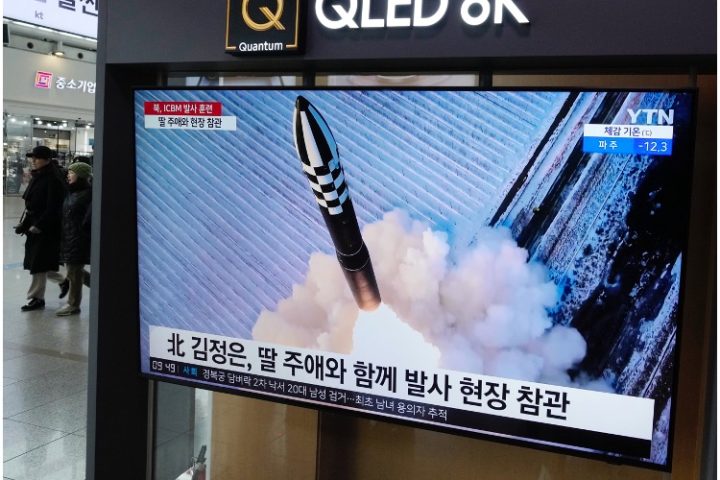
On Monday, December 18, the communist regime of North Korea launched an intercontinental ballistic missile (ICBM) with sufficient range to target anywhere in the United States, said South Korea and Japan, signifying the North’s second launch in hours as Pyongyang denounced a U.S.-led show of force as “war” moves.
The missile was reported to be able to travel more than 15,000 kilometers, implying that it can reach anywhere in Japan and the mainland United States, announced Japan’s Parliamentary Vice-Minister of Defense Shingo Miyake.
South Korea’s National Security Council described the missile as a solid-fuel ICBM, condemning the launch as a destabilizing act that breached international warnings and various UN Security Council resolutions.
President Yoon Suk-yeol had ordered the overhaul of the effective operation of “nuclear deterrence” by South Korea and the United States, it declared in a statement.
Monday’s missile was fired from an area near the capital Pyongyang toward the sea off the North’s east coast and flew about 1,000 kilometers, South Korea’s Joint Chiefs of Staff stated.
Japan’s Defense Ministry reported that the flight lasted 73 minutes, just short of the 74-minute flight by an ICBM North Korea fired in July.
The missile reached a maximum altitude of more than 6,000 km and fell into the sea west of Hokkaido outside Japan’s exclusive economic zone, Japan added.
A missile fired at a lofted trajectory with such a height likely means the projectile can reach 15,000 kilometers on a normal trajectory, based on analyses of previous North Korean long-range missile tests.
Such launches highlight the North’s efforts to advance its arsenal with longer-range weapons that could potentially reach the mainland United States.
The area near the international airport serving Pyongyang was where the North hitherto fired ICBMs and is suspected to be the location of a missile assembly facility.
The North’s latest solid-fuel Hwasong-18 ICBMs have been launched from near Pyongyang, at a grass field that analysts have contended was likely reinforced with concrete for the heavy launch vehicle.
The missile launch on December 18 came after North Korea fired a short-range ballistic missile on the night of December 17, flying about 570 kilometers and falling into the ocean.
North Korea followed up that launch with a strong statement slamming the United States for orchestrating what it termed as a “preview of a nuclear war,” including the arrival of a nuclear-powered submarine in South Korea on December 17.
White House National Security Advisor Jake Sullivan spoke with his South Korean and Japanese counterparts and underscored the importance of sharing missile warning data, the White House said.
The missile launch on December 18 was the second suspected move by North Korea in a matter of hours and came after Pyongyang pledged to adopt “more offensive countermeasures” in retaliation to a meeting between U.S. and South Korean defense officials on December 15. Furthermore, the missile launch was North Korea’s fifth ICBM launch in 2023 — the highest number in a single year so far.
At the December 15 meeting in Washington, both the United States and South Korea agreed to war-game the use of nuclear weapons in drills scheduled to take place next summer. Following the meeting by U.S. and South Korean officials, Washington warned that any nuclear attack would lead to the end of the North Korean regime.
Moreover, South Korea’s Defense Ministry revealed that the United States, South Korea, and Japan have been working to establish a real-time missile data sharing system, but such a system is still “a few days” from going operational.
North Korea posited on December 15 that it had a sovereign right to operate a ballistic missile program for self-defense, rebuffing a UN Security Council ban that it claimed was a result of hostile U.S. policy.
After the launch on December 17, North Korea’s defense ministry accused “military gangsters” in the United States and South Korea of heightening tensions with drills, displays of force, and nuclear war planning.
The statement by an unnamed ministry spokesman quoted the arrival of the U.S. nuclear-powered submarine Missouri in the South Korean port city of Busan on December 17.
Visits by U.S. nuclear submarines had formerly been rare, but they have been ramped up under agreements between Seoul and Washington that have bolstered the arrivals of U.S. military assets, including a nuclear ballistic missile submarine and long-range strategic bombers.
In November, U.S. aircraft carrier USS Carl Vinson also arrived at Busan as part of an effort to increase deterrence against North Korea’s nuclear and missile programs.
“The escalation of the North Korean threat is an ominous development under current circumstances,” said Seoul National University law professor Lee Jae-min.
Tensions between the two Koreas have increased since Pyongyang successfully put its first spy satellite into orbit on November 21.
A 2018 inter-Korea military accord to halt all antagonistic acts against each other was then abandoned.
North Korea has since reinstalled guard posts and started redeploying heavy arms within the demilitarized zone that divides the north and south.
Professor Lee viewed North Korea’s actions as a reaction to the strengthening alliance between the United States and South Korea, and the trilateral military cooperation among the United States, South Korea, and Japan.
Professor Yang Moo-jin, president of the University of North Korean Studies, told Yonhap News that the ICBM launch shortly after the consultations “demonstrates the North’s strong will to confront South Korea and the US with a purpose of claiming its initiative in matters on the Korean Peninsula.”
Like Professor Yang, Professor Lee predicts that North Korea will continue to raise tensions ahead of the U.S. presidential election in November 2024, to get attention from both the Biden administration and former president Donald Trump, who is seeking reelection.
Lee opined that North Korea hopes to bring the United States back to the negotiation table with the next U.S. president, particularly if Trump is reelected.
“North Korea is not likely to give up its nuclear weapons, given what has happened in Ukraine and other places, but at least they can agree to disarmament in exchange for the lifting of sanctions against them.”
During his presidential tenure from 2017 to 2021, Trump fostered a congenial relationship with North Korean dictator Kim Jong-un, leading to two rounds of denuclearization talks in Singapore in 2018 and Hanoi in 2019, which eventually fell through.
A Politico report published on December 13 cited unnamed sources as saying that Trump was contemplating a policy shift from denuclearization to disarmament in his approach to North Korea, should he get reelected.
While Trump has disavowed the claims in a post on his social media platform Truth Social, the North Koreans may not stop provocations for attention till November 2024.
Lee warned that responses to such continued provocations will need to be weighed prudently.
“Giving too much attention or reacting too much will be dangerous, because that’s exactly what North Korea is expecting. I think the US, Japan and Korea will need to keep calm and be careful not to play into the North Korean hands.”



